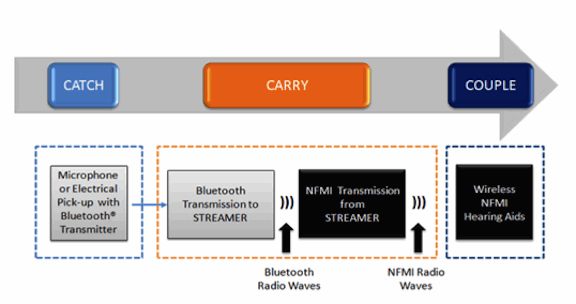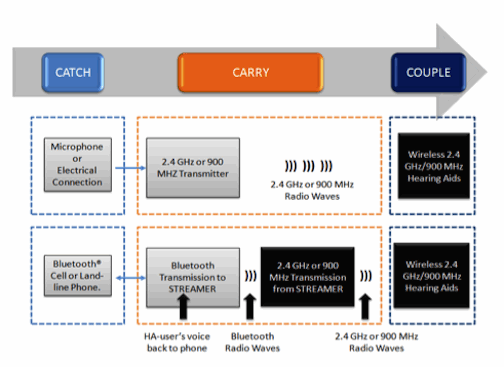I am pleased to announce that this week’s blog, as well as that for next week, will be discussing the state of the art when it comes to wireless systems and hearing aids. Our featured writer, Dr. Cynthia Compton-Conley, is no stranger to ALDs (assistive listening devices), having spent much of her career directly involved in understanding not only how they function, but also in directing how they apply.
To read about an entire series on induction loops for hearing aids, including information about installation of induction loops, type in the word “loops” in the “Google Custom “Search” section to the right. Wayne Staab, Ph.D., Editor
About the Author
Cynthia Compton-Conley, Ph.D., has had a distinguished career as an educator and consumer advocate, specializing in assistive technology and ADA access. Dr. Compton-Conley has motivated and inspired students for decades and is highly esteemed by colleagues for her contributions in the lab, the classroom and the community. Honors and awards include the Special Friends of Hearing Impaired People Award from the Hearing Loss Association of America; the Joel Wernick Award from the Academy of Doctors of Audiology; the Fletcher Award in Technical Applications from the Center for Hearing and Communication; and the Distinguished Achievement Award from the American Academy of Audiology. An alumna of Rutgers University, Vanderbilt University, and the City University of New York, Dr. Compton-Conley taught for three decades at Gallaudet University, where she also served as director of the Assistive Devices Center. Currently, she is enjoying an encore career as Director of Hearing Wellness at Etymotic Research, a research, development, and manufacturing company that has served consumers and hearing professionals for 30 years. Contact Cindy through her website www.soundstrategy.com.
Wireless Systems and Hearing Aids: What’s Available? What’s Coming Down the Pike?
Tools to Help You Decide Among Systems
Traditional Wireless Technologies (FM, Infrared, and Loop)
In the beginning, there was the hearing aid, and it was good – but not so good in noise and beyond the critical distance (within the reverberant field). Thus, wireless systems were developed to improve audibility and enhance the signal-to-noise/reverberation ratio. Over the years, advances in technology have rendered a number of products that can be used to enhance face-to-face communication, the reception of media, and telephone conversations. What follows is an outline of currently available assistive listening devices (ALDs), how they are used, and how you can integrate this knowledge into your practice. Finally, I will predict what the future holds and introduce a cool new online needs-assessment tool (just released) that consumers can use to determine their ALD needs.
FM, Infrared, and Induction Loop Systems
Three basic systems – FM (frequency modulation), infrared and induction loop – were introduced and continue to be enjoyed today in homes, in the workplace and in public areas such as classrooms, lecture halls, and auditoriums. All three technologies consist of a wireless transmitter that picks up an acoustic signal via a microphone placed near the talker’s mouth or by plugging the transmitter into a TV, stereo system, or mixer of a large area public address (PA) system. Listeners have a choice of how they can couple to each of these systems.
FM, infrared and loop systems can be used with receivers equipped with earphones. FM and infrared receivers can be coupled to hearing aids or implants using induction (neckloop or silhouettes) or direct auditory input (DAI) cords. Behind-the-ear (BTE) FM receivers integrated into or plugged into hearing aids, implants or hearing aid streamers alleviate the need for cords and provide more cosmetic appeal. Induction loop systems have special advantages because the receiver – the telecoil (T) – can be placed inside hearing aids, implants, or hearing aid streamers. Despite being labeled by some as “old fashioned” technology, loops have enjoyed a renaissance among consumers due to the fact that a telecoil-equipped hearing aid or implant user feels extremely empowered when s/he can walk into any loop-equipped venue and, without having to ask permission to hear (or endure the frustration of locating a hygienic and functioning FM or infrared receiver), can set the hearing aids/implants/ streamer to “T” and experience the wonder of hearing as clearly as possible thanks to the elimination of background noise and reverberation.
Each of the three systems has its pros and cons, depending upon the needs of the patient and the situation. For example, while loop systems are convenient in large areas and the living room, FM may be preferred when portability (moving from class to class, skiing lessons, etc.) is prized. Infrared may be required for highly secure environments such as the workplace of defense contractors and government agencies.
Newer 2.4 GHz and 900 MHz Technologies (used with or without hearing aids)
Recently, we have witnessed the arrival of newer technologies on the scene. Body style adaptive digital 2.4 GHz systems, such as Williams Sound’s Digiwave and Bellman and Symfon’s Domino Pro as well as Comfort Audio’s 900 MHz Comfort Digisystem and Comfort Contego, are available to enhance face-to-face communication, reception of media, and phone communication. These systems can be used with earphones or can be coupled to hearing aids using various coupling methods. The Comfort Digisystem, which also offers a mini receiver and a micro receiver that look like BTE FM universal receivers, operates at 900 MHz. Phonak has also introduced Roger, a 2.4 GHz digital system that employs design-integrated receivers as well as a universal miniature receiver for all brands of hearing aids and implants.
The Three Cs of Wireless Technology
All wireless assistive technologies perform three actions – The 3 Cs. They catch the signal of interest, they carry it to the listener, and they couple the signal to the listener. Figure 1 summarizes this process for the technologies mentioned above. A microphone or direct electrical connection is employed to catch the signal of interest. The signal is then converted to an FM, infrared, induction, 2.4 GHz or 900 MHz signal and is then transmitted (carried) to a receiver that is coupled to the listener’s ears, hearing aids or implants.
In addition to the systems discussed above, the company that provides my paycheck, Etymotic Research, will soon be offering a new 2.4 GHz system, the next generation of Companion Mics, the CM4. This unique system will allow up to four people to both talk to, and also hear, each other in restaurants and other acoustically compromised settings. This system can be used with Etymotic’s high-fidelity, noise-isolating insert earphones or can be coupled to hearing aids and implants via a neckloop or silhouette inductors.
Wireless Hearing Aid Systems
A second set of wireless technologies is offered by various hearing aid manufacturers. Each of these wireless hearing aid systems comprises various wireless transmitters and transceivers that are used with hearing aids containing tiny wireless radio receivers. I have taken the liberty of classifying these systems into two main types: (1) Totally Streamer – Dependent Systems and (2) Partially Streamer – Dependent Systems. The word “streamer” refers to an intermediary or gateway device that is used to receive one type of radio signal, change it to another type of radio signal and then re-broadcast it to the internal hearing aid receivers. Since the gateway device both receives and transmits signals, it is also called a transceiver.
Figure 2 illustrates how a Totally Streamer-Dependent System functions. To catch the signal of interest, a remote Bluetooth® microphone is worn on a talker’s lapel. The microphone picks up the talker’s voice, which is then changed to a Bluetooth signal that is broadcast to the listener’s hearing aid streamer. A remote Bluetooth transmitter also may be directly connected to the audio jack of a TV or other electronic device to broadcast the media signal to the listener’s streamer. In addition, the hearing aid streamer can be paired to a Bluetooth land-line phone, cell phone or other Bluetooth-enabled device.
Some streamers (not shown in the figure above) also contain on-board microphones as well as jacks for the hardwired connection of audio devices such as personal players and BTE FM receivers. The streamer then takes the acoustic, electrical, Bluetooth, inductive, or FM signal and converts it to near field magnetic induction (NFMI) radio waves, which are then broadcast to NFMI receivers located inside the hearing aids. Whether engaged in face-to-face communication, the reception of media, or a telephone conversation, Totally Streamer- Dependent Systems must always be used with a streamer worn, carried by, or placed near the listener, unless, of course, the hearing aids themselves contain telecoils. For example, if the hearing aids contain telecoils, then hearing aid users could use their telecoil-equipped hearing aids alone with a room loop. In this case, a streamer would not be needed. Companies that offer these types of systems include, but are not limited to Oticon, Siemens, Unitron, Widex, and Phonak.
Figure 3 shows how Partially Streamer-Dependent Systems work. As of this writing, there are two types of these hearing aid systems available: (1) 2.4 GHz (ReSound) and (2) 900 MHz (Starkey). When engaging in face-to-face communication or the reception of media, a streamer is not needed because a 2.4 GHz or 900 MHz transmitter is used to broadcast the talker’s voice or the TV/stereo signal directly to the wireless hearing aids containing either proprietary 2.4 GHz or 900 MHz radio receivers. A streamer carried by the listener is needed only when pairing to Bluetooth phones and other devices. This is so that the hearing aid user can hear the person on the other end of the line via Bluetooth and 2.4 GHz or 900 MHz transmission and the person on the opposite end of the line can hear the hearing aid user’s voice via the microphone housed on the Bluetooth streamer that also transmits back to the phone – thus the name, Partially Streamer-Dependent Systems.
Part II of this series by Dr. Compton-Conley will appear next week. In Part II, she will predict what the future holds and introduce a cool new online needs-assessment tool (just released) that consumers can use to determine their ALD needs.










Very informative content. We’re having success with Hearing Loop systems here in Southern California. Among the appeal is that there is nothing to wear, to check-out, to maintain, to account for, and with most hearing aids containing T-Coils, the end user is self sufficient.
Thank you for your comments. Be certain to look for Part II of this next week.
The amount and variety of technology coming on line right now is staggering and exciting. Each serves one or more purposes and does it well but none serve all purposes well. It was especially encouraging to see that you are not among the substantial number who relegate induction loop technology to being “old fashioned” and not a valid solution to some communication problems.
No new technology, by itself, can offer the convenient and instant communication access of a loop system in a large venues. Arrive late – push a button and you hear with no need to track down a borrow a headset. Those manufacturers who recognize this fact now include a telecoil in their streamer/gateway device to add induction loop access to the many other remarkable features contained in their latest devices.
Wonderful article. Thank you. It has given me some clarification on issues that I could not understand. I, too, favor induction loop systems in large public settings because of their wireless connection directly to my t-coils.
Great, great blog post! Anyone interested in modern hearing loss technology should read it. I few observations:
I’m amazed at how needlessly complicated this all is. Yes, it is true that my own streamer-based devices work, and I use them regularly and am reasonably satisfied (except with the sound quality, which is grainy, distorted, and weak in bass). However, I would not recommend the streamer system I use for anyone who has cognitive issues or is technophobic. It requires regular re-pairing and a considerable amount of fiddling. I’ve heard about similar problems with other companies’ wireless ald technology. I suspect that the few people who buy these devices quickly get frustrated, and sadly, they often the devices lie unused in a drawer.
My suspicion is that if it were simple and affordable, an integrated, compatible assistive listening system could be used by many people even if there were cognitive issues. It would be very successful as it would solve huge unmet needs, especially related to speech in noise and theater applications. Until both the products and choices are simplified, however, I really think wireless ALDs will be significantly underutilized (with the exception of hearing loops, which are both simple AND affordable).
Wireless hearing assistance has tremendous potential, but it is at the level of development that the personal computer was at before the introduction of the Apple II.
Thank you for the excellent article Cynthia. How far we’ve come in the area of ALDs since I first met you through SHHH nearly 30 years ago! Like others who are excited about the current Hearing Loop movement, I can’t say enough about the wonders of that technology in large venues; and of course via neckloops with other personal audio devices. The benefits I’ve received from all 3 technologies, including FM and IR have kept me in the hearing mainstream for years. A key to much of that has been ‘a willingness to use it openly’, and I have. FM made it possible for me to earn a master’s degree; it also has kept me socially involved as I continue to use it frequently in noisy social settings. Once I discovered these options, isolation and withdrawal from social events was no longer an option for me. Both my CI processor and hearing aid need upgrading and/or replacement soon. It’s exciting to be able to consider the wireless options that are either available now or will be soon. I look forward to reading Part II of your article on ALD technology! Many thanks for all the wonderful work you have done and continue to do! Julie Olson